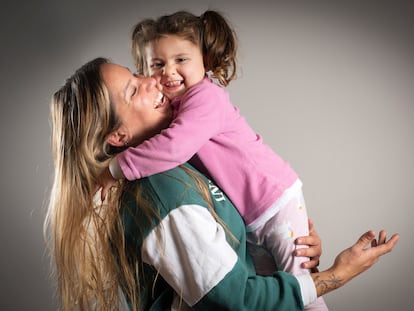The second revolution in gene therapy that has cured Javier, a child with a lethal error in the X chromosome
An Italian foundation that helped a young boy overcome Wiskott-Aldrich syndrome becomes the first non-profit in the world to request approval of these innovative treatments from the European Medicines Agency and the FDA
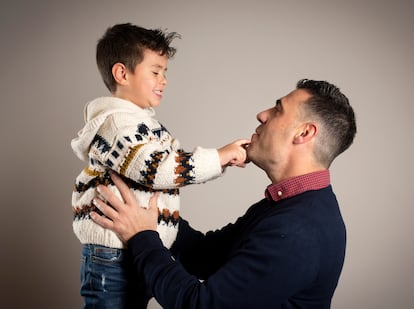
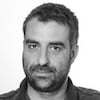
A “small strand of blood in the poop.” This was the first sign, initially viewed as unimportant, that put Jesús Lunar and Cristina López on the trail that something was happening with their son’s health. Javier had been born on June 12, 2020, and before the discovery, which occurred a few days later, everything had been following the chaotic routines that new members of any family impose. Six months later, however, the doctors sat the couple down and gave them the news that was going to change their lives.
“We were told that Javier had Wiskott-Aldrich syndrome, a rare genetic disease that affects the immune system. At first we didn’t know how to react, it was hard for us to accept that it could be fatal. But then something in your head clicks. You tell yourself that you have to keep going and that everything that needs to be done will be done. And so it has been to this day,” says this computer programmer born in 1982.
Javier is almost five years old now and, apart from some minor neurological problems, he has grown up like any other child. Not only is he cured, but he has also been at the center of a double revolution. The first has been scientific, with the development of gene therapies. These treatments manage to replace the patient’s defective gene with a healthy one that is introduced into the body using a virus that’s been modified in the laboratory. Javier is the first child in Spain to have managed to overcome Wiskott-Aldrich syndrome (WAS) using this procedure.

“The truth is that, despite what they have had to go through, the family has been very lucky. Or, in other words, science has come to the rescue at the last minute. The only curative treatment for these children is a bone marrow transplant. But there was no compatible donor, neither in their family environment nor in the Josep Carreras Foundation’s donor bank. Without a transplant, these children rarely reach adolescence and practically never survive to the age of 20. But, at the last minute and almost by chance, Javier had the opportunity to enter the clinical trial of gene therapy,” explains Manuel Santamaría, a professor of Clinical Immunology and the specialist at the Reina Sofía Hospital in Córdoba who handled his case.
The second revolution in which the child has taken part affects the pharmaceutical market. Innovative therapies are not reaching many patients who need them. The high prices imposed by pharmaceutical companies, the companies' commercial strategies and regulatory issues often become insurmountable obstacles. The therapy that Javier received was on the verge of being shelved forever halfway through development because the pharmaceutical company Orchard Therapeutics did not see the viability of a treatment for a condition that affects less than one in every 250,000 male children born alive.
The Telethon Foundation (FT), linked to the San Raffaele public hospital in Milan (Italy) —where research on the drug began more than 15 years ago—, saved the treatment. The entity agreed with the company to take over and complete the development of the therapy and, on February 3, announced that it had requested approval from the European Medicines Agency (EMA). It is the first non-profit entity in the world to take this step with a gene therapy, something it also plans to do with the FDA in the United States. A move of this nature only has one similar precedent, that of the Hospital Clínic in Barcelona with CAR-T therapies against some types of hematological cancer.
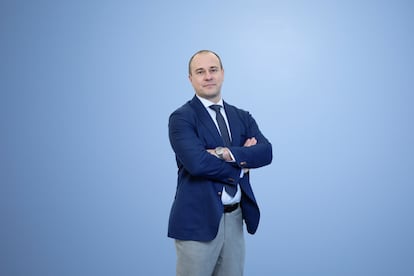
“Hopefully other similar institutions will follow our lead. We don’t want to be the only ones and we think that our experience can be a model to follow in the development of innovative therapies for rare diseases that affect so few patients that the pharmaceutical industry is not interested in investing in them,” Celeste Scotti, head of Research and Development, told EL PAÍS at the entity’s headquarters in Milan.
Scotti recalls that the Foundation had already taken an important step by keeping another gene therapy from Orchard Therapeutics on the market, Strimvelis, indicated for severe combined immunodeficiency of adenosine deaminase (ADA-SCID), another very rare genetic disease that affects the so-called bubble babies. “But this case represents an important qualitative leap. Strimvelis already had the approval of the EMA, while now we are the ones who have completed the development of the therapy and requested the approval of the regulatory bodies,” he adds.
Wiskott-Aldrich syndrome is caused by a mutation in a gene responsible for producing a protein essential for the functioning of immune system cells. This gene is located on the X chromosome, so the disease almost always affects boys, as is the case with haemophilia. In women, since they have two X chromosomes, the healthy gene on one can replace the defective gene on the other, although if they have a son, there is a 50% chance that they will pass on the disease to him.
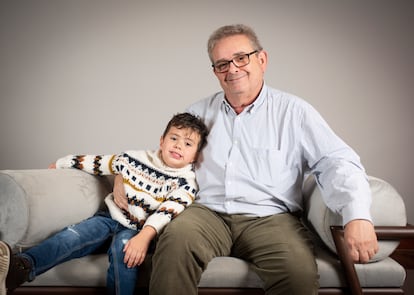
“These are children who, without curative treatment, have a very short life expectancy. It is a complex disease to diagnose, which requires genetic confirmation. But then, in addition, you need to find a compatible donor for the bone marrow transplant, which is not always possible. This is why gene therapy is so important. Without it or the transplant, the health of children deteriorates rapidly with poor quality of life in what we call the triad: recurrent infections, hemorrhages and eczema,” explains Santamaría.
According to the Telethon Foundation, children born with Wiskott Aldrich syndrome are one in a range of 250,000 to 1,000,000 male newborns. Research has not revealed major geographical differences in its incidence around the world, although these results may be influenced by the scarcity and disparity of existing studies and the lack of means in some areas of the world to diagnose this type of disorder.
This low incidence and the large number of rare diseases described — there are more than 7,000, according to the World Health Organisation (WHO) — pose a huge challenge when it comes to selecting where to invest research resources and how to make treatments commercially viable. “We have two great advantages over pharmaceutical companies. We are a non-profit organization, so we do not have to pay back our investors. And we do not have to recover the investment made in research, which is very high but which we finance thanks to donors, who are citizens and companies. Our researchers also receive funding from national and European public plans,” explains Scotti.
Despite these initial advantages, the head of Research and Development at the Foundation points out that these therapies are still very expensive: “Developing the lentiviral vector, for example, is very expensive. Then you need to extract the patient’s cells, modify them, treat them, maintain them and inject them again. All of this without any margin of error, with the highest degree of quality and safety. We are talking about hundreds of thousands of euros. But, in any case, these costs are a small part of the million-dollar prices set for the latest gene therapies approved by the EMA and the FDA.” To date, a total of 30 children have benefited from the TF gene therapy, whose name is etuvetidigene autotemcel.
The industry association Farmaindustria does not see steps such as those taken by the Telethon Foundation as bad, provided that “treatments developed in the academic field [or by non-profit entities] follow the same evaluation and approval circuit as industrial ones.” According to the sector, this is the way to guarantee that “therapies will meet the same standards of quality, efficacy and safety.”
The cardiologist Soledad Cabezón, president of the Association for Fair Access to Medicines (AAJM) and former member of the European Parliament for the Spanish Socialist Party (PSOE), believes, on the contrary, that administrations should promote “a new model of authorizations without commercial or lucrative interest for therapies developed by public hospitals and non-profit entities” with the aim that “these can be extended and shared with other national or European entities.”
Jesús Lunar remembers the first months of his son’s life as “very hard.” “After the shock of receiving the news, a window of hope opened for us with gene therapy. But those were very complicated times. We were in the midst of a pandemic and Milan was one of its epicenters. We spent seven months there and, with all the uncertainties, it was difficult to cope with,” he says.
There was a moment, however, when everything began to change. “When they inject him with the therapy, you remain in a kind of limbo. You can’t do anything, just wait. You try not to think about it too much, but it’s impossible. And then one day, suddenly, the doctors tell you that the corrected gene has started to work. The child’s platelets have normalized, all the symptoms have subsided… They tell you that you only need to go to check-ups every six months. But now you see that the child is fine. It’s something extraordinary, impossible to describe,” he exclaims.
Sign up for our weekly newsletter to get more English-language news coverage from EL PAÍS USA Edition
Tu suscripción se está usando en otro dispositivo
¿Quieres añadir otro usuario a tu suscripción?
Si continúas leyendo en este dispositivo, no se podrá leer en el otro.
FlechaTu suscripción se está usando en otro dispositivo y solo puedes acceder a EL PAÍS desde un dispositivo a la vez.
Si quieres compartir tu cuenta, cambia tu suscripción a la modalidad Premium, así podrás añadir otro usuario. Cada uno accederá con su propia cuenta de email, lo que os permitirá personalizar vuestra experiencia en EL PAÍS.
¿Tienes una suscripción de empresa? Accede aquí para contratar más cuentas.
En el caso de no saber quién está usando tu cuenta, te recomendamos cambiar tu contraseña aquí.
Si decides continuar compartiendo tu cuenta, este mensaje se mostrará en tu dispositivo y en el de la otra persona que está usando tu cuenta de forma indefinida, afectando a tu experiencia de lectura. Puedes consultar aquí los términos y condiciones de la suscripción digital.
More information
Archived In
Últimas noticias
ICE raids trigger school absenteeism and traumatize children: ‘They have been forced to leave their childhood behind’
Mexico’s missing people crisis casts a shadow over World Cup venue
Can cheese protect brain health? This is what the science says
Maude Apatow, from acting in ‘Euphoria’ to directing: ‘There are many films that you can tell weren’t written by someone young’
Most viewed
- Christian Louboutin: ‘Young people don’t want to be like their parents. And if their parents wear sneakers, they’re going to look for something else’
- US sanctions against jailed cartel leader ‘El Marro’ highlight Mexico’s lack of control over its prisons
- Cartels in Mexico take a leap forward with narco-drones: ‘It is criminal groups that are leading the innovation race’
- Liset Menéndez de la Prida, neuroscientist: ‘It’s not normal to constantly seek pleasure; it’s important to be bored, to be calm’
- ‘El Limones’ and the growing union disguise of Mexican organized crime

